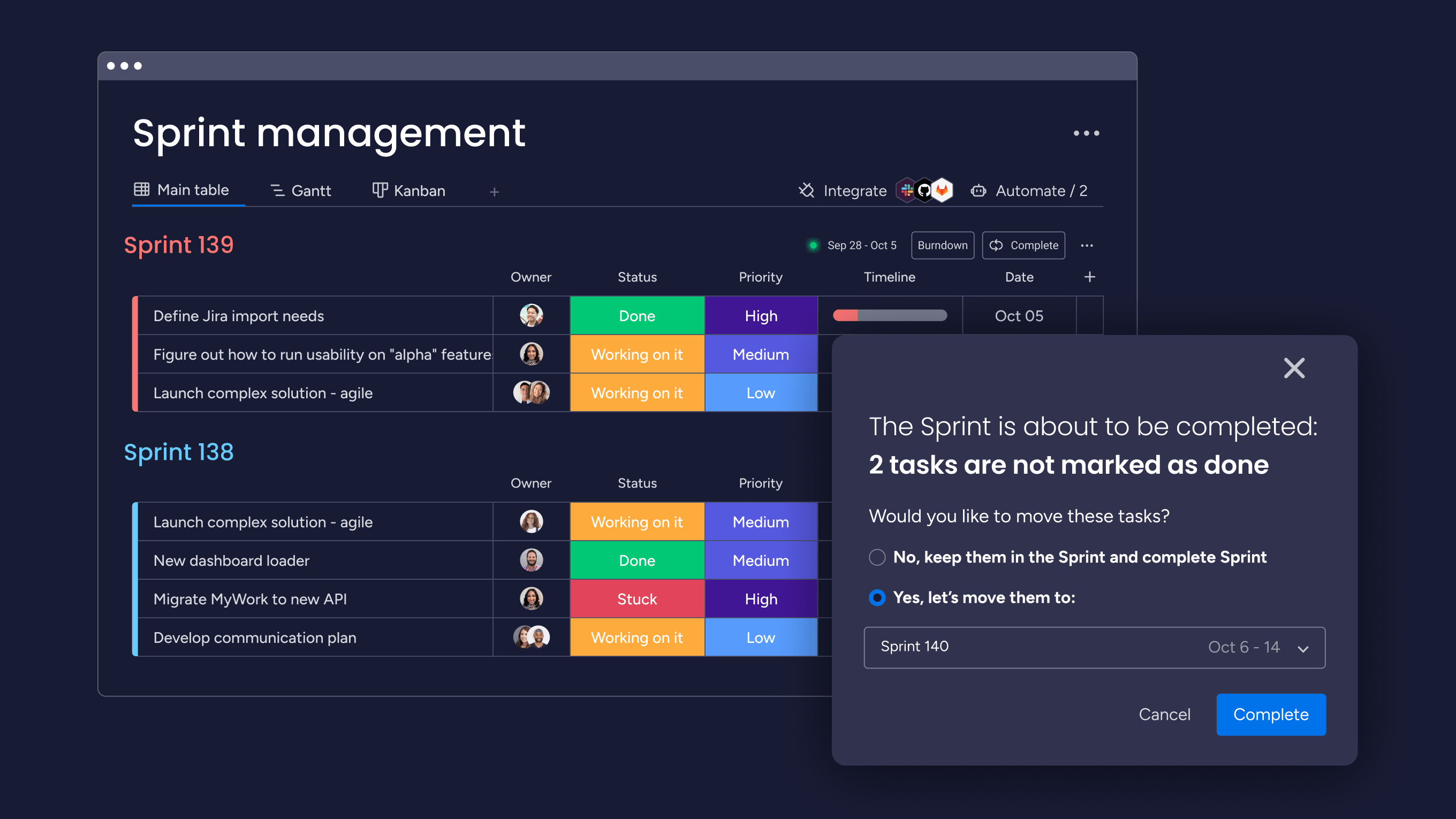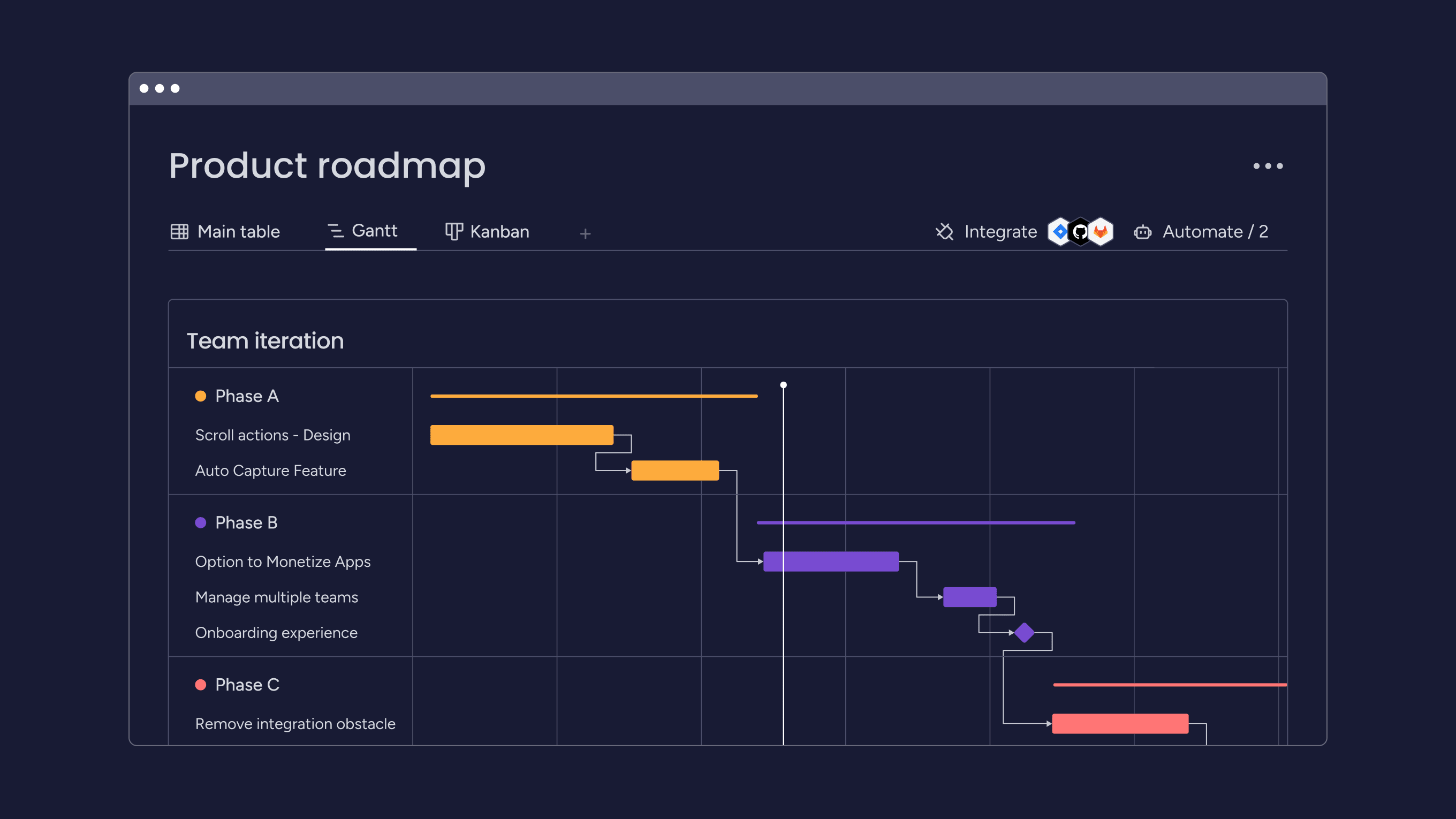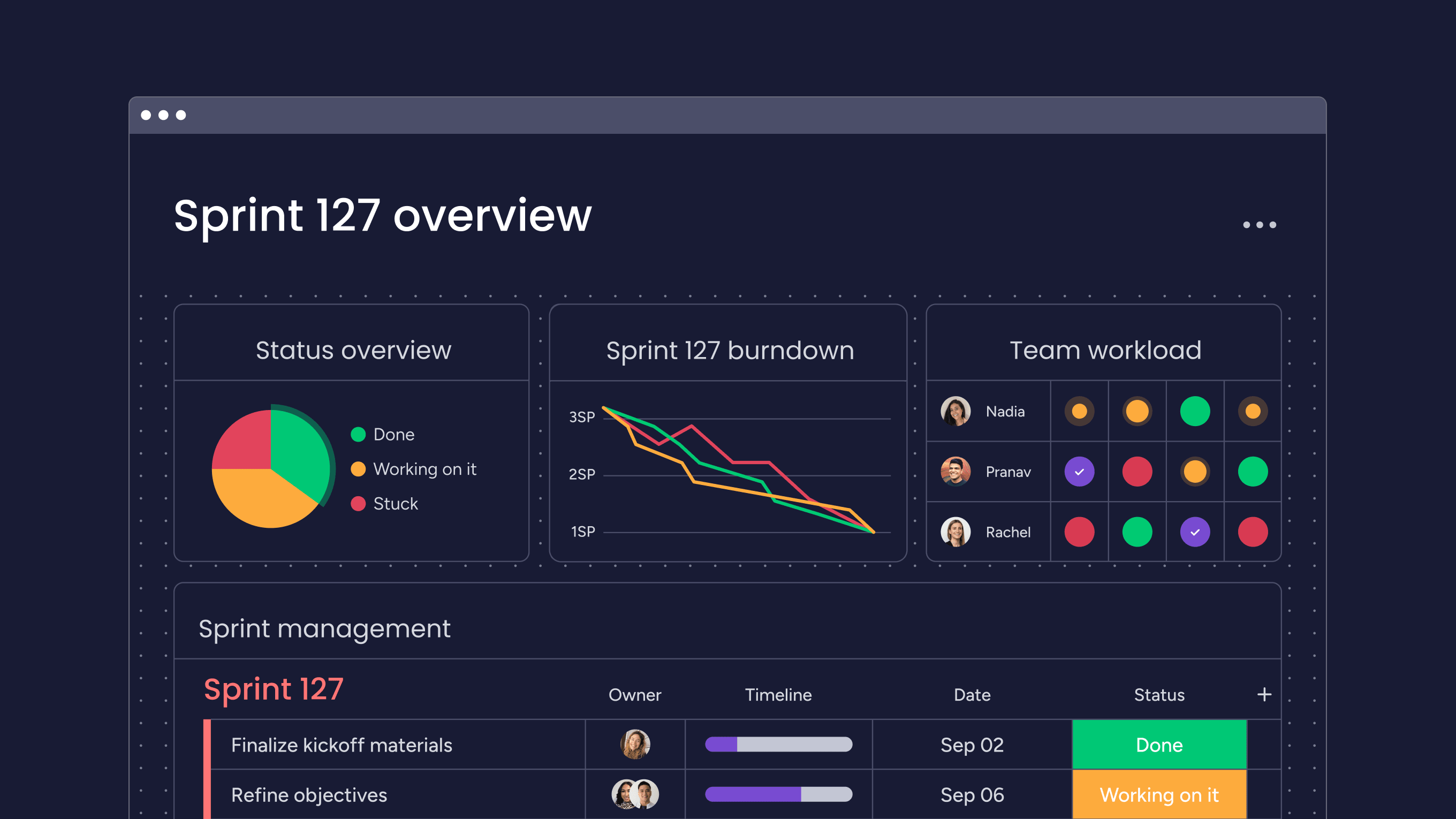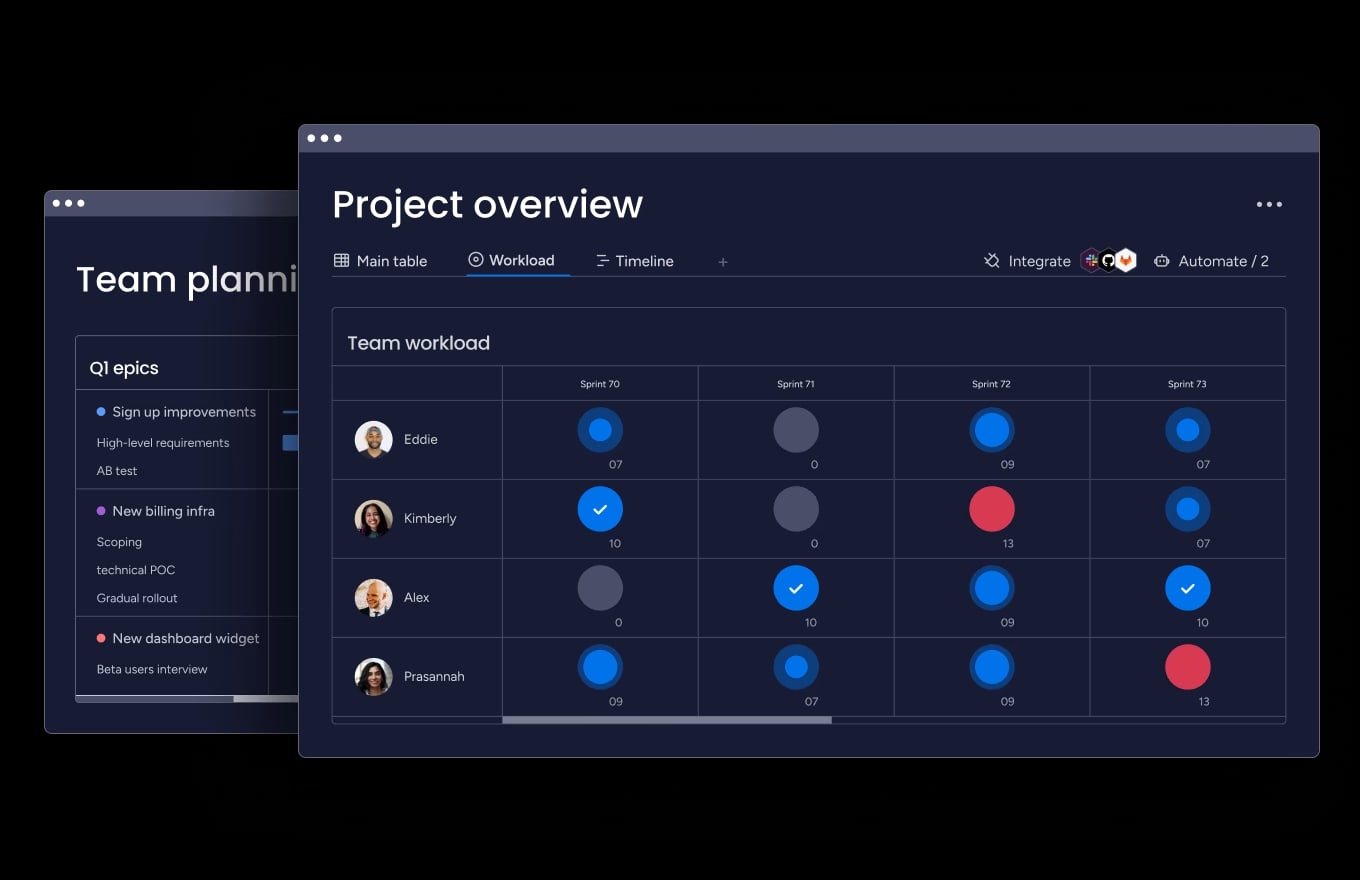Agile has become the backbone of modern product development, but within it, Scrum continues to stand out as the most widely adopted framework for turning ideas into working products quickly. As projects grow more complex and teams become increasingly distributed, the need for clarity, collaboration, and adaptability has never been greater.
Scrum gives teams a repeatable rhythm for delivering real value fast — using short, focused sprints to plan, build, review, and improve continuously. It replaces rigid project timelines with an iterative approach that keeps everyone aligned on priorities and progress. When done right, it helps teams stay flexible without sacrificing accountability or momentum.
In this guide, we break down everything you need to know about Scrum in 2025 — from roles, events, and artifacts to proven implementation steps and modern tools that make it easier to manage. You will learn how to apply Scrum effectively, avoid common pitfalls, and see how platforms like monday dev can bring the framework to life for teams of any size.
Key takeaways
- Frequent delivery: Scrum helps teams release working software every one to four weeks instead of waiting months for one big launch. This pace keeps projects adaptable and ensures what you build reflects real customer feedback.
- Clarity and alignment: transparency, inspection, and adaptation work together to keep progress visible, highlight issues early, and make it easy to adjust course before problems grow.
- Defined roles: success depends on clear responsibilities — Product Owners set priorities, Scrum masters coach and clear roadblocks, and developers focus on building the product.
- Continuous improvement: teams often notice benefits within two to three sprints, but it usually takes three to six months to reach full effectiveness. Regular retrospectives make growth part of the process.
- Smarter workflows with monday dev: customizable boards, real-time collaboration, and automated reporting cut down on admin tasks while giving teams the visibility Scrum requires, so more time goes into building and less into managing.
What is Scrum framework?
Scrum is a lightweight framework designed to help teams tackle complex work without getting bogged down in rigid processes. It’s built around a set of roles, events, and artifacts—all connected by a handful of simple rules—that keep collaboration structured but flexible.
At its heart, Scrum is about people working together to solve problems. Teams learn by doing, organize themselves to get work done, and use regular reflection to build on their successes and improve where things fall short.
Understanding Scrum methodology
Scrum methodology is a way to manage product development that focuses on delivering value in short cycles. This means your team works in time-boxed periods called sprints, typically lasting one to four weeks, where you create working software that customers can actually use.
The methodology operates on three pillars that guide everything you do:
- Transparency: everyone can see what’s happening in the project.
- Inspection: you regularly check your work and progress.
- Adaptation: when something isn’t working, you change it immediately.
Scrum vs Agile vs Waterfall
Choosing a project management approach isn’t just about following trends: it directly shapes how your team plans, collaborates, and delivers. Scrum, Agile, and Waterfall each take a very different path to getting work done, and the right fit depends on your goals, your timeline, and how much flexibility you need along the way.
The table below breaks down the key differences in Agile vs Scrum and Waterfall, so you can see, at a glance, how these approaches stack up:
| Aspect | Scrum | Agile | Waterfall |
|---|---|---|---|
| Approach | Fixed-length sprints with specific ceremonies | Flexible philosophy with various frameworks | Sequential phases completed one at a time |
| Planning | Every 1-4 weeks | Continuous and adaptive | All upfront before work begins |
| Changes | Welcome within sprint boundaries | Embrace change anytime | Resist after planning phase |
| Delivery | Working software every sprint | Regular increments | One big release at the end |
| Team structure | Self-organizing with defined roles | Collaborative without fixed roles | Specialized teams for each phase |

Why development teams choose Scrum
Development teams turn to Scrum when they need to deliver value quickly while staying flexible, and its popularity is growing — a 2023 survey from Parabol found that 87% of agile practitioners use Scrum, a significant increase from previous years.
Traditional methods often fail when requirements change or when you need rapid market feedback. With Scrum, you deliver working software every few weeks instead of waiting months, which gives stakeholders something tangible to review and ensures you’re building the right thing.
Key benefits of Scrum implementation
- Faster delivery: ship working features every on weeks instead of waiting for one big release.
- Clear visibility: everyone sees progress through daily meetings and sprint reviews.
- Early problem detection: catch issues in weeks, not months.
- Team ownership: your team decides how to do the work, leading to faster decisions.
- Happy customers: regular feedback means you build what users actually want, with agile organizations reporting a 30% improvement in customer satisfaction.
When to use the Scrum framework
Scrum works best when you’re dealing with uncertainty and need flexibility. Consider using it when your project involves discovering requirements as you go, when customer feedback will shape the product, or when you need to show progress regularly.
It’s particularly effective for new product development, competitive markets where speed matters, or projects using emerging technologies where you’ll learn as you build.
The 3 pillars of Scrum theory
Scrum stands on three pillars of Scrum that work together to help teams navigate complexity. Without these pillars, Scrum becomes just another set of meetings.
Each pillar supports the others, creating a cycle where you can see what’s happening, check if it’s working, and make changes quickly.
Transparency in Scrum
Transparency means making work visible to everyone involved, a goal that can be challenging in large enterprises where only 61% of employees are satisfied with transparency. This includes showing what you’re working on, how you’re doing it, and what “done” actually means.
Transparency is achieved through artifacts like the Product Backlog and Sprint Backlog that everyone can see. Daily Scrums are also one of the essential Scrum meetings that let the team share progress and blockers openly. Finally, Sprint Reviews show working software to stakeholders so they know exactly what’s been built.
Inspection process
Inspection in Scrum isn’t a single event: it’s something that happens throughout every sprint. The idea is to step back often and check whether the work is moving in the right direction, whether it meets stakeholder needs, and whether the team’s way of working is actually effective.
Daily Scrums give a quick look at progress toward the sprint goal. Sprint Reviews invite stakeholders to see the product and share feedback. Sprint Retrospectives turn the attention inward, helping the team reflect on how they worked together and where they can improve next time.
Adaptation principles
When inspection shows something isn’t working, you adapt immediately. This might mean changing your approach mid-sprint, adjusting the product based on feedback, or improving how your team collaborates.
The key is making changes as soon as you spot problems. Don’t wait for the perfect moment — adapt now and refine later.

The 5 core Scrum values
Scrum values are the glue that hold the framework together. They guide how people show up, collaborate, and make decisions day to day. Without them, Scrum risks becoming a set of empty rituals — meetings that happen on schedule but don’t deliver real progress or trust.
These five values give teams the mindset they need to make Scrum work in practice, not just on paper:
1. Commitment
Commitment means dedicating yourself to the team’s goals and the Sprint Goal. You’re not committing to a fixed scope but to doing your best work and supporting your teammates.
This looks like showing up to all Scrum events, helping teammates when they’re stuck, and focusing on the Sprint Goal even when other work seems interesting.
2. Courage
Courage means speaking up when something’s wrong and tackling difficult problems head-on. It takes guts to tell stakeholders that a feature will take longer than expected or to try a new technical approach.
Teams need courage to be transparent about mistakes, challenge unrealistic deadlines, and have honest retrospectives where real issues get discussed.
3. Focus
Focus means concentrating on the Sprint Goal and avoiding distractions. Your team commits to specific work for the Sprint, and that’s where your energy goes.
Time-boxes help maintain focus by creating urgency. When you know the Sprint Review is coming, you naturally prioritize finishing work over starting new things.
4. Openness
Openness creates an environment where problems get solved quickly. When you’re open about challenges, your team can help. When you share what you’re learning, everyone benefits.
This means admitting when you’re stuck, sharing both good and bad news in Sprint Reviews, and being honest in retrospectives about what needs to improve.
5. Respect
Respect recognizes that everyone brings valuable skills and perspectives. You trust your teammates to do good work and value their input even when you disagree.
Respect shows up in how you communicate during Daily Scrums, how you handle disagreements about technical approaches, and how you support each other’s growth.
Scrum team structure and accountabilities
A Scrum team typically has ten or fewer people working together to deliver value. The framework defines three key accountabilities that ensure the team can deliver effectively.
Keep in mind that these aren’t job titles (they’re accountabilities) and in smaller teams, one person might wear multiple hats.
Product Owner role
The Product Owner maximizes the value of the product by managing what gets built and in what order. They’re the voice of the customer and the business within the team.
Key responsibilities include:
- Managing the Product Backlog: deciding what features to build and their priority.
- Stakeholder communication: gathering feedback and managing expectations.
- Defining value: making clear what success looks like for each feature.
- Making trade-offs: choosing between competing priorities based on value.
The Product Owner needs to be available to answer questions and make decisions quickly so the team keeps moving forward.
Scrum Master responsibilities
The Scrum Master helps everyone understand and use Scrum effectively. They’re a servant-leader who removes obstacles and helps the team improve.
Their work includes:
- Coaching the team: helping everyone understand Scrum and work together effectively.
- Facilitating events: making sure meetings happen and stay productive.
- Removing blockers: clearing obstacles that slow the team down.
- Protecting the team: shielding them from distractions and interruptions.
Development team members
Developers are the people who do the work of creating the product. This includes programmers, designers, testers — anyone who helps build the increment.
Developers self-organize to figure out how to accomplish the Sprint Goal. They hold each other accountable for quality and help decide what they can realistically accomplish each Sprint.

The 5 essential Scrum events
Scrum events create a rhythm for your team’s work. Each event has a specific purpose and time limit to keep things focused and productive.
These events work together to help you plan work, track progress, get feedback, and improve continuously.
Sprint planning meeting
Sprint Planning kicks off each Sprint by deciding what to build and how to build it. The whole team collaborates to select items from the Product Backlog and create a Sprint Goal.
You’ll discuss what can realistically be done in the Sprint and break down the work into smaller pieces. By the end, everyone should understand what you’re building and why it matters.
Daily Scrum stand-up
The Daily Scrum is a 15-minute meeting where developers plan their day. It’s not a status report — it’s a planning session to coordinate work and identify problems.
Team members share what they did yesterday, what they’ll do today, and any blockers they face. This keeps everyone aligned and surfaces issues quickly.
Sprint Review session
A Sprint Review takes place at the end of each sprint as a chance to showcase the work that’s been completed. Stakeholders see the product in action and share feedback that helps shape what comes next.
It’s designed to be a collaborative discussion, not just a presentation. The team walks through what was achieved, what’s still outstanding, and what adjustments might be needed. From there, the Product Owner updates priorities so future work reflects the latest insights.
Sprint Retrospective
The Sprint Retrospective is where your team improves how you work together. You’ll discuss what went well, what didn’t, and what specific changes to make next Sprint.
Focus on actionable improvements rather than just venting. Pick one or two things to change and commit to trying them in the next Sprint.
The Sprint cycle
The Sprint is a container for all other events, lasting one to four weeks. During this Scrum sprint, you create a usable increment of the product.
New sprints start immediately after the previous one ends. This creates a sustainable pace where you deliver value regularly. monday dev helps manage this cycle with Sprint templates, automated workflows, and burndown charts that show your progress in real-time.
The 3 key Scrum artifacts
Scrum artifacts make work visible and help everyone understand what’s being built. Each artifact serves a specific purpose in keeping the team aligned.
These artifacts evolve throughout the project as you learn more about what customers need and what’s technically possible.
Product Backlog management
The Product Backlog is a living list of everything that might be needed in the product. It’s never complete — new items get added as you learn more about user needs.
The Product Owner orders items by value, risk, and dependencies. Items at the top are refined and ready to build, while items further down might just be rough ideas. The Product Goal provides the long-term objective that guides these priorities.
Sprint Backlog creation
The Sprint Backlog contains the items selected for the current Sprint plus a plan for delivering them. It belongs to the developers who update it throughout the Sprint.
This artifact makes the team’s plan visible to everyone. As work progresses, the team updates the Sprint Backlog to reflect what they’ve learned. The Sprint Goal provides focus and flexibility for what to accomplish.
Product Increment delivery
The Increment is the sum of all completed work that meets your Definition of Done. Each Sprint produces at least one Increment that’s potentially releasable.
Your Definition of Done ensures everyone agrees on what “complete” means. This might include code reviews, testing, documentation — whatever your team needs for production-ready work.

How to implement Scrum successfully: 7 steps
Getting started with Scrum requires thoughtful preparation and commitment from your whole team. These steps outlined below will help you build a strong foundation.
Remember that Scrum is a framework, not a rigid prescription. Adapt these steps to fit your context while keeping the core principles intact.
Step 1: Assemble your Scrum team
Build a team with all the skills needed to deliver working software. Aim for three to nine people to keep communication simple while having diverse expertise.
Identify who will take each accountability. Make sure everyone understands their role and how they’ll work together. In small teams, people might wear multiple hats, but keep the accountabilities clear.
Step 2: Define product vision and goals
Create a compelling vision that explains why this product matters. Your vision should inspire the team and guide decisions throughout development.
Set measurable goals that support the vision. Focus on outcomes like user adoption or revenue rather than just features to build. These goals help the Product Owner prioritize the backlog.
Step 3: Build your product backlog
Start with high-level features based on user needs and business goals. Don’t try to define everything upfront — you’ll learn and adjust as you go.
Write user stories that explain who needs something, what they need, and why. Include acceptance criteria so everyone knows when something is done. Keep initial items simple and refine them as they move up the backlog.
Step 4: Plan your first Sprint
Choose a Sprint length between one to four weeks and stick with it. Select backlog items the team can realistically complete in that time.
Create a Sprint Goal that explains what you’re trying to achieve. Break selected items into smaller work items that can be completed in a day or two. Make sure everyone understands the plan before starting work.
Step 5: Conduct daily Scrums
Pick a consistent time and place for your 15-minute daily meeting. Focus on coordination, not status reports.
Keep the discussion focused on progress toward the Sprint Goal. If deeper conversations are needed, take them offline with just the people involved.
Step 6: Review and demonstrate progress
Invite the right stakeholders to see what you’ve built. Show working software, not slides or reports.
Gather feedback on what to build next. Use this input to update the Product Backlog and plan future sprints. Make this a conversation, not just a presentation.
Step 7: Reflect and improve
Run retrospectives that lead to real changes. Focus on specific improvements you can try next Sprint rather than general complaints.
Track whether your improvements actually help. Start small — even tiny changes can make a big difference when you do them consistently.
Overcoming common Scrum challenges
Every team faces obstacles when implementing Scrum, a significant organizational change that can be difficult to manage. In fact, research shows only 23% of individual contributors believe change is managed ‘very well’ in their organizations. Knowing what to expect helps you address issues before they derail your progress.
The key is staying focused on solutions while maintaining Scrum’s core principles.
Managing stakeholder expectations
Stakeholders used to traditional projects often want detailed plans and fixed deadlines. Help them understand how Scrum’s flexibility actually reduces risk.
Show them how Sprint Reviews provide visibility and influence over the product. Explain that changing priorities based on feedback leads to products users actually want. Regular delivery of working software builds trust faster than any status report.
Dealing with scope creep
Scrum handles changing requirements through the Product Backlog. New ideas don’t disrupt the current Sprint — they go in the backlog for prioritization.
The Product Owner decides what’s most valuable and makes trade-offs transparent. When stakeholders want to add something, they see what gets pushed down. This clarity helps everyone make informed decisions about priorities.
Maintaining team velocity
A team’s velocity will naturally fluctuate as the type and complexity of work changes. What matters most isn’t the number from a single sprint, but the trend over time. Looking at agile velocity across several sprints gives a clearer picture of how steadily the team is delivering.
Drops in velocity often point to deeper issues — like vague requirements, mounting technical debt, or too many external dependencies. The key is addressing these causes early instead of just pushing the team to move faster. With built-in velocity charts and sprint analytics, monday dev makes it easier to spot those patterns, understand what’s slowing you down, and take action before it impacts delivery.

Scaling Scrum for enterprise organizations
Scrum works brilliantly for small, focused teams, but scaling it across a large organization introduces new challenges. When multiple teams are working on connected products, the risk of misalignment grows — and with it, the need for more intentional coordination.
The goal is to expand without losing what makes Scrum effective: agility, autonomy, and rapid feedback. Striking the right balance between team independence and organizational alignment is what allows enterprises to stay nimble while still moving in the same direction.
Multi-team coordination
When teams share a product, they need regular sync points. Many organizations use Scrum of Scrums — representatives from each team meet to coordinate dependencies and integration.
Keep these coordination meetings focused on impediments and dependencies, not status updates. Teams should remain autonomous in how they accomplish their goals while staying aligned on what they’re building.
Portfolio level planning
Connect team-level work to business strategy through portfolio planning. This ensures resources go to the most valuable initiatives.
Use techniques like OKRs to cascade strategic goals down to team Sprint Goals. Regular portfolio reviews help adjust priorities based on market changes and team discoveries. Keep planning lightweight to maintain agility.
Cross-functional alignment
Development teams need to coordinate with marketing, sales, and support. Include these stakeholders in Sprint Reviews and release planning.
Create clear communication channels between teams and departments. Regular touchpoints ensure everyone’s prepared for releases and customer feedback flows back to development teams quickly.
How monday dev powers modern Scrum teams
Scrum works best when tools support the framework instead of getting in the way. Built on the monday Work OS, monday dev gives teams a clear way to plan sprints, collaborate in real time, and track progress without extra overhead.
Everything that follows — from customizable workflows to instant communication and automated reporting — fits together to remove common blockers and help teams stay focused on delivering value.
Customizable Sprint workflows
Create boards that match your exact process. Whether you follow textbook Scrum or have adapted it to your needs, monday dev flexes to fit with pre-built Scrum templates and drag-and-drop customization.
Set up custom columns for your workflow stages, create automated status changes based on Git activity, and design multiple board views including Kanban, Calendar, and Gantt. The Sprint Planning widget helps teams allocate work effectively while the capacity planning tool prevents overcommitment.
Real-time collaboration features
Scrum moves quickly, so teams need a way to stay aligned without relying on endless emails or scattered tools. monday dev makes collaboration feel seamless by keeping conversations, updates, and progress visible in one place.
- Instant updates: comments, mentions, and notifications ensure important details are seen right away.
- In-platform code review: an embedded code viewer lets developers review code without switching tools.
- Connected workflows: integrations with Slack, Microsoft Teams, GitHub, GitLab, and Bitbucket bring Scrum artifacts into the tools your team already uses.
- Mobile flexibility: the monday dev app keeps team members engaged in Daily Scrums and sprint updates, even when they’re working remotely.
Automated Scrum reporting
Get insights without manual effort. Interactive burndown charts update automatically, velocity tracking dashboards show trends over time, and sprint summaries generate themselves with the Sprint Retrospective widget capturing action items for continuous improvement.
The Story Points tracker helps teams measure complexity consistently, while the Bug Tracker dashboard shows quality trends across sprints. These reports support inspection and adaptation by making data readily available and visualizing it through customizable widgets that stakeholders can access via shareable dashboards.
Frequently asked questions
How long does it take to implement Scrum successfully?
Most teams implementing Scrum successfully start seeing benefits within two to three sprints, though reaching full effectiveness typically takes three to dix months. The timeline depends on team experience, organizational support, and how well stakeholders adapt to iterative delivery.
Can Scrum work for non-software development teams?
Yes, Scrum can work for non-software teams doing complex, creative work where requirements evolve and iterative delivery adds value. Marketing teams use Scrum for campaign development, HR teams for recruitment projects, and product development teams for physical products, though they may need to adapt some practices.
What Scrum Master certifications should professionals pursue?
Professionals pursuing Scrum Master certifications should consider the Certified ScrumMaster (CSM) from Scrum Alliance or Professional Scrum Master (PSM) from Scrum.org as the most recognized options. CSM focuses on practical application and coaching, while PSM emphasizes deep understanding of the Scrum Guide.
How do you measure Scrum team performance effectively?
Measuring Scrum team performance effectively means tracking value delivery through Sprint Goal achievement, customer satisfaction scores, and product quality metrics rather than individual productivity. Velocity helps with planning but shouldn't be used to compare teams or set performance targets.
What is the difference between Scrum and Kanban methodologies?
The difference between Kanban vs Scrum methodologies is that Scrum uses fixed-length sprints with specific roles and ceremonies to deliver increments, while Kanban focuses on continuous flow with work-in-progress limits. Scrum suits teams needing regular planning cycles, while Kanban works for steady, unpredictable work streams.
How often should teams update their Scrum practices?
Teams should update their Scrum practices during every Sprint Retrospective by making small, continuous improvements rather than waiting for major overhauls. Significant framework changes might be considered quarterly or when team composition shifts, always keeping core Scrum principles while adapting practices for effectiveness.
 Get started
Get started 


